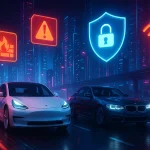Emerging Trends in Automotive Cybersecurity Threats and Solutions
Modern cars are basically computers on wheels—packed with sensors, software, and connectivity features. That’s great for convenience, sure, but it also opens up a Pandora’s box of cybersecurity risks. Hackers aren’t just after your laptop anymore; they’re eyeing your car’s infotainment system, braking controls, even the steering. Let’s break down what’s happening—and how the industry’s fighting back.
Why Automotive Cybersecurity is Heating Up
Remember when car theft meant hotwiring? Those days are long gone. Today’s threats are digital, silent, and often invisible until it’s too late. Here’s why:
- More connected features: Over-the-air updates, Bluetooth, Wi-Fi hotspots—every connection is a potential entry point.
- Legacy systems: Many carmakers still use outdated software architectures that weren’t built with hacking in mind.
- Supply chain risks: A single vulnerable component from a third-party supplier can compromise the whole vehicle.
Top Automotive Cybersecurity Threats Right Now
1. Remote Exploits
Hackers can take control of a car’s systems from miles away. In 2021, researchers demonstrated how they could unlock and start a Tesla Model X using a Bluetooth relay attack—no physical access needed.
2. Ransomware Attacks
Imagine your car’s infotainment system freezing with a ransom demand. It’s not sci-fi—attackers have already targeted electric vehicle charging stations with ransomware.
3. Data Theft
Cars collect a lot of data: GPS locations, driving habits, even your contacts. A breach could expose sensitive personal info.
4. ECU Manipulation
Engine Control Units (ECUs) are the brain of your car. If hacked, attackers could disable safety features or even cause accidents.
How the Industry is Responding
Automakers aren’t sitting idle. Here’s what’s changing:
- Secure-by-design principles: New cars are being built with cybersecurity baked in from the start.
- Over-the-air (OTA) patches: Tesla pioneered this, but now Ford, GM, and others are rolling out regular security updates.
- AI-driven threat detection: Machine learning helps spot anomalies in real-time—like sudden, unexplained braking commands.
What You Can Do (Yes, You)
While carmakers handle the heavy lifting, drivers aren’t powerless. A few simple steps:
- Update regularly: Don’t ignore those software update notifications.
- Limit connectivity: Turn off Bluetooth or Wi-Fi when not in use.
- Check for recalls—some include cybersecurity fixes.
The Road Ahead
As cars get smarter, so do the threats. The next frontier? Autonomous vehicles, which could be even more vulnerable. But with regulations like UN R155 pushing for stricter standards, the industry’s starting to shift gears. The question isn’t if cybersecurity will improve—it’s how fast.










